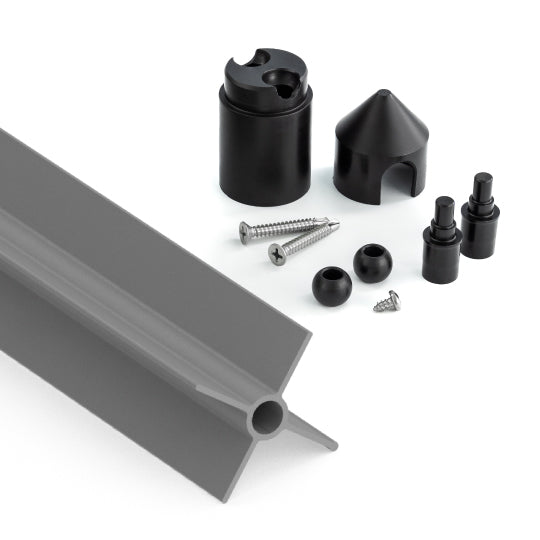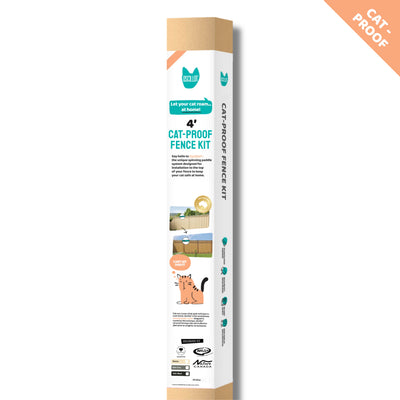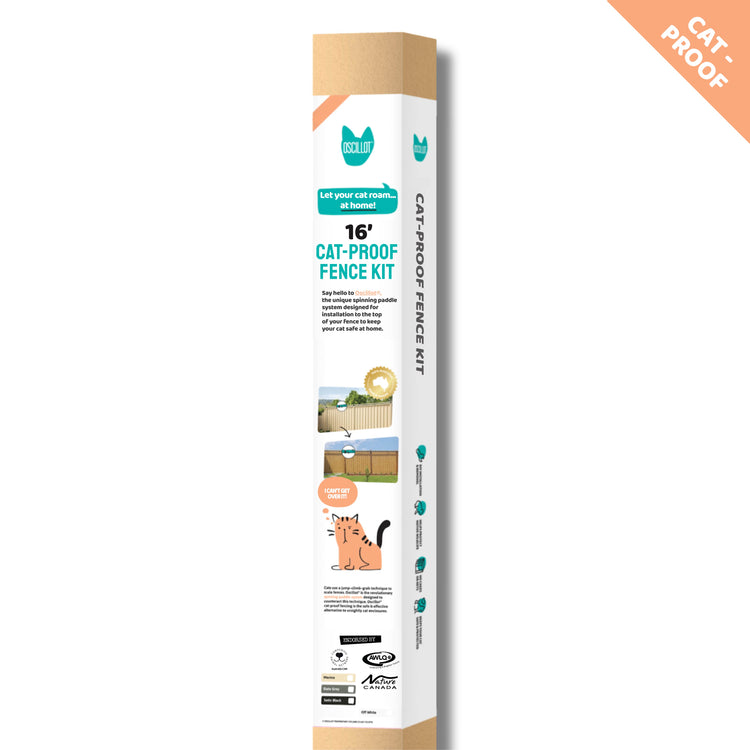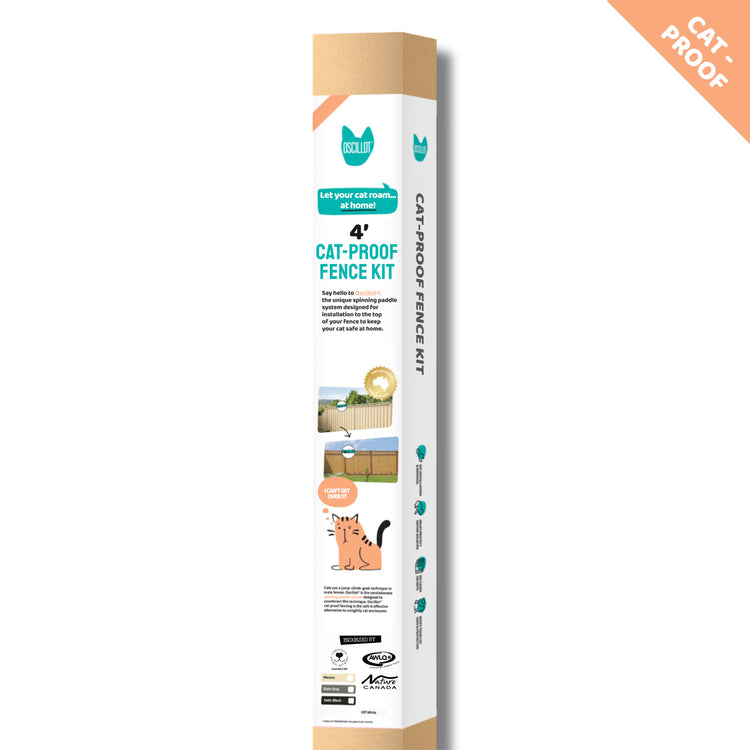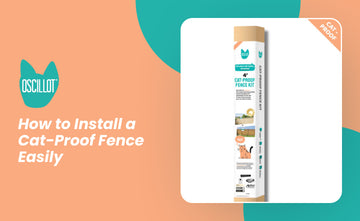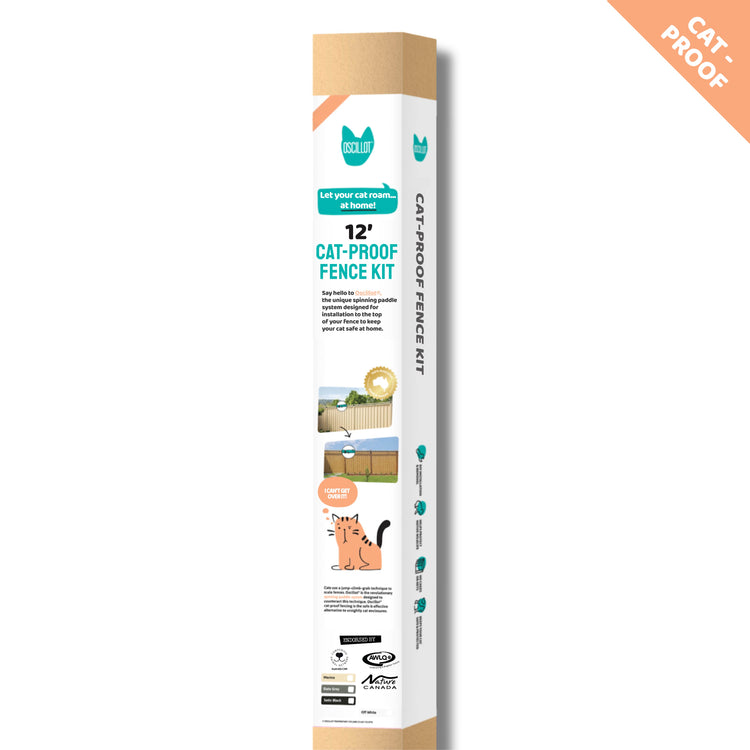The European Guide to Cat Containment Systems: Keeping Your Feline Safe Outdoors

Introduction to Cat Containment in Europe
In many European countries, cat owners face unique challenges when keeping their beloved felines safe while allowing them outdoor access. Unlike some regions where indoor-only cats are common, European cat owners often prefer to give their cats access to gardens and outdoor areas. This approach recognizes the importance of environmental enrichment for feline mental and physical health. However, this desire for outdoor access must be balanced with safety concerns.
European urban and suburban environments present numerous hazards for free-roaming cats, including busy roads, predators, and the risk of getting lost. In many European countries, there's also growing awareness about the impact outdoor cats can have on local wildlife, particularly birds and small mammals.
The good news is that innovative cat containment systems like Oscillot's cat-proof fence solutions offer a perfect compromise. These systems allow European cat owners to create safe outdoor spaces where their cats can enjoy fresh air, sunshine, and enrichment without the risks of unrestricted roaming.
Key Takeaways
- European cat owners face unique challenges balancing outdoor access with safety concerns
- Oscillot cat containment systems offer humane solutions adapted to various European property types
- DIY installation is straightforward for most European fence types including stone walls, wooden fences, and metal railings
- Special solutions are available for European gardens with trees and dense vegetation
- Seasonal adaptations are necessary for different European climate zones
- Kit sizes range from 1.2 meters (€50) to 62 meters (€1,295) to accommodate properties of all sizes
- All Oscillot products come with a 60-day money-back guarantee and 3-year warranty
Understanding Why Cat Containment Matters in Europe
Before looking at specific containment solutions, it's important to understand why keeping your cat within your property boundaries is so crucial in European settings. The reasons reflect deeper concerns about animal welfare, environmental care, and community relationships.
Safety Concerns
European roads are often busy, with high-speed traffic that poses big risks to roaming cats. Studies across various European countries show that road accidents are one of the leading causes of death for outdoor cats. In the UK alone, it's estimated that over 230,000 cats are hit by cars each year, with many of these accidents being fatal. The dense road networks in Europe make this risk particularly serious.
Depending on your location, your cat may also face risks from predators like foxes, large birds of prey, or aggressive dogs. In some rural areas, there might also be concerns about wildlife that could harm your cat or spread diseases.
Wildlife Protection
Many European countries have policies to protect local wildlife, particularly bird populations. Free-roaming cats, even well-fed ones, are natural hunters and can impact local ecosystems. By keeping your cat within your property, you're not only keeping them safe but also being a responsible environmental caretaker.
Research from the Royal Society for the Protection of Birds (RSPB) and similar organizations across Europe has shown the impact of domestic cats on bird populations, especially during nesting season. Responsible cat ownership includes thinking about how to reduce hunting of vulnerable species.
The Oscillot Cat Containment System: A European Solution
One of the most effective and humane ways to keep your cat within your property is by using a specialized cat containment system like Oscillot. This system has become popular across Europe for its effectiveness, good looks, and easy installation.
How Oscillot Works
The Oscillot system has rotating paddles that are mounted on top of your existing fence. When a cat tries to climb over the fence, these paddles rotate, preventing the cat from getting a secure grip. This humane method keeps cats within boundaries without causing harm or distress. It works with cats' natural behaviors rather than against them, creating a mental barrier rather than a painful deterrent.
The system works well for European properties because:
1. It works with various fence types common across Europe, including wooden fences, brick walls, and metal fences
2. It's designed to handle diverse European weather conditions, from the rainy climate of the UK and Ireland to the hotter Mediterranean regions
3. Its discreet design fits with European aesthetic preferences and often meets local planning rules
Available Oscillot Solutions for European Properties
Depending on the size and layout of your European property, Oscillot offers various kit options:
Small European Gardens: 1.2 to 5 Metre Kits
For typical urban European gardens or small terraced house yards, the smaller Oscillot kits work well:
- Oscillot® 1.2 Metre Cat-Proof Fence Kit (€50.00): Includes 1 Paddle and 2 Dual Knuckle Post Kits, perfect for securing a small section of fence or a garden gate. This is great for narrow passages or small courtyard entrances common in historic European city centers.
- Oscillot® 2.5 Metre Cat-Proof Fence Kit (€64.00): Perfect for small courtyard gardens common in European city centers. This size works well for the cozy outdoor spaces typical in places like Paris, Barcelona, or Amsterdam.
Medium to Large European Properties: 12.4 to 37.2 Metre Kits
For suburban European homes with larger gardens or rural properties:
- Oscillot® 12.4 Metre Cat-Proof Fence Kit (€288.00): Perfect for typical suburban European gardens. This kit is well-suited for detached homes in countries like Germany, France, or Sweden, where garden sizes tend to be more generous than in city centers.
All Oscillot kits come with a 60-day money-back guarantee and a 3-year manufacturer's warranty, giving European customers peace of mind about their investment in cat safety.
DIY Installation of Cat Containment Systems in European Settings
One advantage of the Oscillot system is that it's designed for DIY installation, making it accessible to European homeowners regardless of their technical skills. This is valuable considering the high cost of professional services in many European countries.
Basic Installation Steps for European Properties
The installation process is straightforward and can be adapted to various fence types common across Europe:
1. Measure your fence perimeter: Accurately measure the total length of fencing you need to secure. Remember to account for gates and any other access points. For European properties with irregular boundaries, it's best to measure each section separately.
2. Choose the appropriate kit size: Based on your measurements, select the Oscillot kit that provides enough coverage for your property.
3. Gather necessary tools: Most European homeowners will already have the basic tools required, including a drill, screwdriver, and measuring tape. For stone or masonry walls common in European properties, you might also need a masonry drill bit and appropriate anchors.
For detailed installation guidance specific to European fence types, you can refer to Oscillot's comprehensive installation guide.
Adapting Installation for European Fence Types
European properties feature diverse fence types, and the Oscillot system can be adapted to work with most of them:
- Stone or brick walls: Common in Mediterranean countries and historic European neighborhoods, these can be fitted with Oscillot using appropriate masonry fixings.
- Wooden fences: Typical in Northern European countries, these are straightforward for Oscillot installation using standard wood screws.
- Metal railings: Found throughout Europe, especially in urban areas, these require specific mounting techniques that are covered in the installation guide.
Addressing Specific European Challenges: Trees and Dense Vegetation
European gardens often have mature trees and dense vegetation, which can create challenges for cat containment. Cats are natural climbers, and trees near fence lines can provide an escape route. This challenge is particularly noticeable in established European gardens, where vegetation may be centuries old.
Tree Guards for European Gardens
To address the challenge of trees within or near your cat containment area, Oscillot offers specialized tree guards:
- Cat-Proof Tree Guard (€25.99): Designed to prevent cats from climbing trees and potentially escaping your secured area. These guards fit trees with a diameter of 23.5cm or smaller, which covers many ornamental trees common in European gardens.
For larger trees, which are common in established European gardens, two tree guards can be combined to fit trunks with larger diameters. This flexibility makes the system adaptable to the varied vegetation found in European outdoor spaces.
Managing Dense Vegetation
European gardens, particularly in rainy regions, often have dense shrubs and hedges that cats might use to climb near fence lines. Here are strategies to address this challenge:
1. Strategic pruning: Keep a gap between dense vegetation and your fence line. In many European countries with regular rainfall, vegetation grows quickly and needs regular maintenance.
2. Vegetation barriers: For hedges that form part of your boundary (common in many European neighborhoods), consider installing Oscillot paddles directly on top of the hedge line where possible.
3. Creating distraction zones: Set up designated areas with cat-friendly plants away from boundaries. This approach works with your cat's natural behaviors rather than constantly fighting against them.
Creating Cat-Friendly European Outdoor Spaces Within Containment
Once you've secured your European property's boundaries with an Oscillot system, the next step is to create an enriching outdoor environment that will keep your cat happy and engaged within the contained area.
European Garden Design for Cats
European garden traditions offer great inspiration for creating cat-friendly spaces:
1. Mediterranean-inspired sun spots: Create raised platforms where cats can enjoy the sun, especially important in Northern European countries where sunny days are precious.
2. Alpine rock gardens: These provide interesting textures and levels for cats to explore, similar to the varied terrains found across European landscapes.
3. English cottage garden style: Plant cat-safe herbs and flowers in casual arrangements, providing sensory stimulation through smells and textures.
Cat-Safe Plants for European Climate Zones
When picking plants for your cat garden, choose species that are both safe for cats and suitable for your specific European climate zone:
Northern and Central Europe:
- Catnip (Nepeta cataria) - A traditional European herb that grows well in cooler climates and cats love it
- Cat thyme (Teucrium marum) - A Mediterranean plant that can adapt to cooler regions when planted in sheltered spots
- Valerian (Valeriana officinalis) - A European native with similar effects to catnip, well-suited to the damper conditions of Northern Europe
Avoid plants that are toxic to cats, such as lilies, tulips, daffodils, and ivy, which are unfortunately common in many traditional European gardens.
Seasonal Considerations for Cat Containment in European Climates
European weather conditions vary greatly by region and season, requiring adjustments to your cat containment strategy throughout the year.
Winter Adaptations (Northern and Central Europe)
In regions with cold winters, such as Scandinavia, Germany, and parts of Eastern Europe:
1. Snow considerations: Check your Oscillot system after heavy snowfall, as built-up snow might give cats a platform to climb over the fence.
2. Sheltered outdoor spaces: Create windproof, insulated outdoor shelters within your contained area where cats can still enjoy fresh air without exposure to harsh weather.
3. Shortened outdoor time: During extreme cold, limit your cat's time outdoors and make sure they have fun indoor activities as an alternative.
Summer Considerations (Mediterranean Europe)
In warmer regions like Spain, Italy, Greece, and Southern France:
1. Shade provision: Make sure your contained area includes plenty of shade, as European cats are generally not used to extreme heat.
2. Water features: Include multiple water sources throughout your contained area to keep your cat hydrated during hot Mediterranean summers.
3. Siesta zones: Create cool, quiet resting areas where cats can retreat during the hottest parts of the day, reflecting the natural rhythm of life in Southern European countries.
Conclusion: Creating Safe European Outdoor Spaces for Your Cat
Containing cats in European outdoor settings presents unique challenges but also wonderful opportunities to enrich your cat's life while keeping them safe. The Oscillot cat containment system offers a versatile, effective solution that can be adapted to various European property types, from small urban gardens to extensive rural estates.
By investing in a quality containment system, you're giving your cat the best of both worlds: the freedom to enjoy outdoor experiences with the safety of defined boundaries. This matches perfectly with European values of animal welfare, environmental responsibility, and living in harmony with nature.
Whether you have a small city garden in Amsterdam, a suburban property in Munich, or a countryside home in Tuscany, there's an Oscillot solution that can be tailored to your specific needs. With proper installation and maintenance, these systems provide years of reliable protection, giving you peace of mind while allowing your cat to safely enjoy the fresh air and enrichment that outdoor access provides.
Explore the full range of Oscillot cat containment solutions to find the perfect system for your European property and give your cat the gift of safe outdoor access today.
The European Guide to Cat Containment Systems: Keeping Your Feline Safe Outdoors
Introduction to Cat Containment in Europe
In many European countries, cat owners face unique challenges when keeping their beloved felines safe while allowing them outdoor access. Unlike some regions where indoor-only cats are common, European cat owners often prefer to give their cats access to gardens and outdoor areas. This approach recognizes the importance of environmental enrichment for feline mental and physical health. However, this desire for outdoor access must be balanced with safety concerns.
European urban and suburban environments present numerous hazards for free-roaming cats, including busy roads, predators, and the risk of getting lost. In many European countries, there's also growing awareness about the impact outdoor cats can have on local wildlife, particularly birds and small mammals.
The good news is that innovative cat containment systems like Oscillot's cat-proof fence solutions offer a perfect compromise. These systems allow European cat owners to create safe outdoor spaces where their cats can enjoy fresh air, sunshine, and enrichment without the risks of unrestricted roaming.
Key Takeaways
- European cat owners face unique challenges balancing outdoor access with safety concerns
- Oscillot cat containment systems offer humane solutions adapted to various European property types
- DIY installation is straightforward for most European fence types including stone walls, wooden fences, and metal railings
- Special solutions are available for European gardens with trees and dense vegetation
- Seasonal adaptations are necessary for different European climate zones
- Kit sizes range from 1.2 meters (€50) to 62 meters (€1,295) to accommodate properties of all sizes
- All Oscillot products come with a 60-day money-back guarantee and 3-year warranty
Understanding Why Cat Containment Matters in Europe
Before looking at specific containment solutions, it's important to understand why keeping your cat within your property boundaries is so crucial in European settings. The reasons reflect deeper concerns about animal welfare, environmental care, and community relationships.
Safety Concerns
European roads are often busy, with high-speed traffic that poses big risks to roaming cats. Studies across various European countries show that road accidents are one of the leading causes of death for outdoor cats. In the UK alone, it's estimated that over 230,000 cats are hit by cars each year, with many of these accidents being fatal. The dense road networks in Europe make this risk particularly serious.
Depending on your location, your cat may also face risks from predators like foxes, large birds of prey, or aggressive dogs. In some rural areas, there might also be concerns about wildlife that could harm your cat or spread diseases.
Wildlife Protection
Many European countries have policies to protect local wildlife, particularly bird populations. Free-roaming cats, even well-fed ones, are natural hunters and can impact local ecosystems. By keeping your cat within your property, you're not only keeping them safe but also being a responsible environmental caretaker.
Research from the Royal Society for the Protection of Birds (RSPB) and similar organizations across Europe has shown the impact of domestic cats on bird populations, especially during nesting season. Responsible cat ownership includes thinking about how to reduce hunting of vulnerable species.
The Oscillot Cat Containment System: A European Solution
One of the most effective and humane ways to keep your cat within your property is by using a specialized cat containment system like Oscillot. This system has become popular across Europe for its effectiveness, good looks, and easy installation.
How Oscillot Works
The Oscillot system has rotating paddles that are mounted on top of your existing fence. When a cat tries to climb over the fence, these paddles rotate, preventing the cat from getting a secure grip. This humane method keeps cats within boundaries without causing harm or distress. It works with cats' natural behaviors rather than against them, creating a mental barrier rather than a painful deterrent.
The system works well for European properties because:
1. It works with various fence types common across Europe, including wooden fences, brick walls, and metal fences
2. It's designed to handle diverse European weather conditions, from the rainy climate of the UK and Ireland to the hotter Mediterranean regions
3. Its discreet design fits with European aesthetic preferences and often meets local planning rules
Available Oscillot Solutions for European Properties
Depending on the size and layout of your European property, Oscillot offers various kit options:
Small European Gardens: 1.2 to 5 Metre Kits
For typical urban European gardens or small terraced house yards, the smaller Oscillot kits work well:
- Oscillot® 1.2 Metre Cat-Proof Fence Kit (€50.00): Includes 1 Paddle and 2 Dual Knuckle Post Kits, perfect for securing a small section of fence or a garden gate. This is great for narrow passages or small courtyard entrances common in historic European city centers.
- Oscillot® 2.5 Metre Cat-Proof Fence Kit (€64.00): Perfect for small courtyard gardens common in European city centers. This size works well for the cozy outdoor spaces typical in places like Paris, Barcelona, or Amsterdam.
Medium to Large European Properties: 12.4 to 37.2 Metre Kits
For suburban European homes with larger gardens or rural properties:
- Oscillot® 12.4 Metre Cat-Proof Fence Kit (€288.00): Perfect for typical suburban European gardens. This kit is well-suited for detached homes in countries like Germany, France, or Sweden, where garden sizes tend to be more generous than in city centers.
All Oscillot kits come with a 60-day money-back guarantee and a 3-year manufacturer's warranty, giving European customers peace of mind about their investment in cat safety.
DIY Installation of Cat Containment Systems in European Settings
One advantage of the Oscillot system is that it's designed for DIY installation, making it accessible to European homeowners regardless of their technical skills. This is valuable considering the high cost of professional services in many European countries.
Basic Installation Steps for European Properties
The installation process is straightforward and can be adapted to various fence types common across Europe:
1. Measure your fence perimeter: Accurately measure the total length of fencing you need to secure. Remember to account for gates and any other access points. For European properties with irregular boundaries, it's best to measure each section separately.
2. Choose the appropriate kit size: Based on your measurements, select the Oscillot kit that provides enough coverage for your property.
3. Gather necessary tools: Most European homeowners will already have the basic tools required, including a drill, screwdriver, and measuring tape. For stone or masonry walls common in European properties, you might also need a masonry drill bit and appropriate anchors.
For detailed installation guidance specific to European fence types, you can refer to Oscillot's comprehensive installation guide.
Adapting Installation for European Fence Types
European properties feature diverse fence types, and the Oscillot system can be adapted to work with most of them:
- Stone or brick walls: Common in Mediterranean countries and historic European neighborhoods, these can be fitted with Oscillot using appropriate masonry fixings.
- Wooden fences: Typical in Northern European countries, these are straightforward for Oscillot installation using standard wood screws.
- Metal railings: Found throughout Europe, especially in urban areas, these require specific mounting techniques that are covered in the installation guide.
Addressing Specific European Challenges: Trees and Dense Vegetation
European gardens often have mature trees and dense vegetation, which can create challenges for cat containment. Cats are natural climbers, and trees near fence lines can provide an escape route. This challenge is particularly noticeable in established European gardens, where vegetation may be centuries old.
Tree Guards for European Gardens
To address the challenge of trees within or near your cat containment area, Oscillot offers specialized tree guards:
- Cat-Proof Tree Guard (€25.99): Designed to prevent cats from climbing trees and potentially escaping your secured area. These guards fit trees with a diameter of 23.5cm or smaller, which covers many ornamental trees common in European gardens.
For larger trees, which are common in established European gardens, two tree guards can be combined to fit trunks with larger diameters. This flexibility makes the system adaptable to the varied vegetation found in European outdoor spaces.
Managing Dense Vegetation
European gardens, particularly in rainy regions, often have dense shrubs and hedges that cats might use to climb near fence lines. Here are strategies to address this challenge:
1. Strategic pruning: Keep a gap between dense vegetation and your fence line. In many European countries with regular rainfall, vegetation grows quickly and needs regular maintenance.
2. Vegetation barriers: For hedges that form part of your boundary (common in many European neighborhoods), consider installing Oscillot paddles directly on top of the hedge line where possible.
3. Creating distraction zones: Set up designated areas with cat-friendly plants away from boundaries. This approach works with your cat's natural behaviors rather than constantly fighting against them.
Creating Cat-Friendly European Outdoor Spaces Within Containment
Once you've secured your European property's boundaries with an Oscillot system, the next step is to create an enriching outdoor environment that will keep your cat happy and engaged within the contained area.
European Garden Design for Cats
European garden traditions offer great inspiration for creating cat-friendly spaces:
1. Mediterranean-inspired sun spots: Create raised platforms where cats can enjoy the sun, especially important in Northern European countries where sunny days are precious.
2. Alpine rock gardens: These provide interesting textures and levels for cats to explore, similar to the varied terrains found across European landscapes.
3. English cottage garden style: Plant cat-safe herbs and flowers in casual arrangements, providing sensory stimulation through smells and textures.
Cat-Safe Plants for European Climate Zones
When picking plants for your cat garden, choose species that are both safe for cats and suitable for your specific European climate zone:
Northern and Central Europe:
- Catnip (Nepeta cataria) - A traditional European herb that grows well in cooler climates and cats love it
- Cat thyme (Teucrium marum) - A Mediterranean plant that can adapt to cooler regions when planted in sheltered spots
- Valerian (Valeriana officinalis) - A European native with similar effects to catnip, well-suited to the damper conditions of Northern Europe
Avoid plants that are toxic to cats, such as lilies, tulips, daffodils, and ivy, which are unfortunately common in many traditional European gardens.
Seasonal Considerations for Cat Containment in European Climates
European weather conditions vary greatly by region and season, requiring adjustments to your cat containment strategy throughout the year.
Winter Adaptations (Northern and Central Europe)
In regions with cold winters, such as Scandinavia, Germany, and parts of Eastern Europe:
1. Snow considerations: Check your Oscillot system after heavy snowfall, as built-up snow might give cats a platform to climb over the fence.
2. Sheltered outdoor spaces: Create windproof, insulated outdoor shelters within your contained area where cats can still enjoy fresh air without exposure to harsh weather.
3. Shortened outdoor time: During extreme cold, limit your cat's time outdoors and make sure they have fun indoor activities as an alternative.
Summer Considerations (Mediterranean Europe)
In warmer regions like Spain, Italy, Greece, and Southern France:
1. Shade provision: Make sure your contained area includes plenty of shade, as European cats are generally not used to extreme heat.
2. Water features: Include multiple water sources throughout your contained area to keep your cat hydrated during hot Mediterranean summers.
3. Siesta zones: Create cool, quiet resting areas where cats can retreat during the hottest parts of the day, reflecting the natural rhythm of life in Southern European countries.
Conclusion: Creating Safe European Outdoor Spaces for Your Cat
Containing cats in European outdoor settings presents unique challenges but also wonderful opportunities to enrich your cat's life while keeping them safe. The Oscillot cat containment system offers a versatile, effective solution that can be adapted to various European property types, from small urban gardens to extensive rural estates.
By investing in a quality containment system, you're giving your cat the best of both worlds: the freedom to enjoy outdoor experiences with the safety of defined boundaries. This matches perfectly with European values of animal welfare, environmental responsibility, and living in harmony with nature.
Whether you have a small city garden in Amsterdam, a suburban property in Munich, or a countryside home in Tuscany, there's an Oscillot solution that can be tailored to your specific needs. With proper installation and maintenance, these systems provide years of reliable protection, giving you peace of mind while allowing your cat to safely enjoy the fresh air and enrichment that outdoor access provides.
Explore the full range of Oscillot cat containment solutions to find the perfect system for your European property and give your cat the gift of safe outdoor access today.



